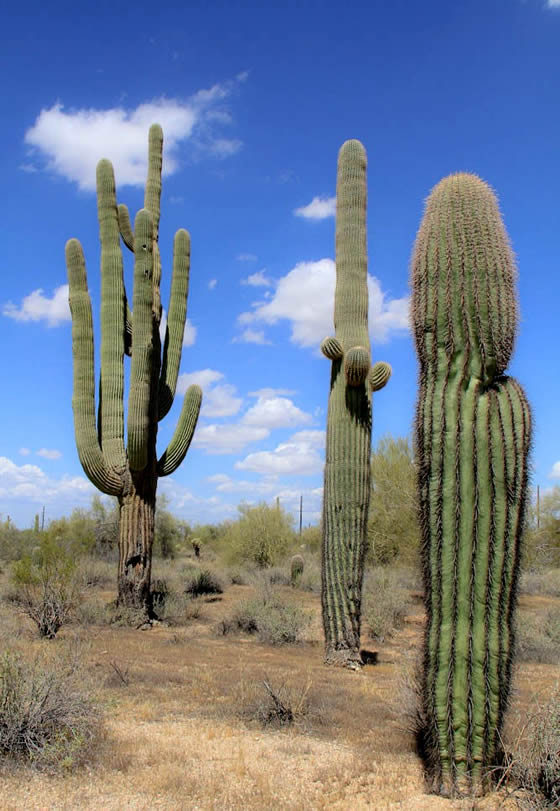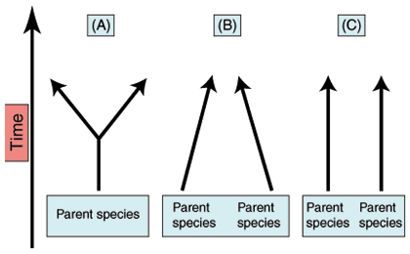Some of the most dramatic examples of natural selection are the result of adaptation in response to stressful climatic conditions. Such selection may cause unrelated species to resemble one another in appearance and function, a phenomenon known as convergence.
In other situations, subpopulations of a single species may split into separate species as the result of natural selection. Such divergence is best seen on isolated islands.
Convergent Evolution
Convergent evolution occurs when organisms from different evolutionary lineages evolve similar adaptations to similar environmental conditions. This can happen even when the organisms are widely separated geographically.
  |
A classic example of convergent evolution occurred with Cactaceae, the cactus family, of the Americas and with the euphorbs, or Euphorbiaceae, the spurge family of South Africa, both of which have evolved succulent (water-storing) stems in response to desert conditions.
The most primitive cacti are vinelike, tropical plants of the genus Pereskia. These cacti, which grow on the islands of the West Indies and in tropical Central and South America, have somewhat woody stems and broad, flat leaves. As deserts developed in North and South America, members of the cactus family began to undergo selection for features that were adaptive to hotter, dryer conditions.
 |
| Cactaceae of the Americas |
The stems became greatly enlarged and succulent as extensive water-storage tissues formed in the pith or cortex. The leaves became much reduced. In some cactus species, such as the common prickly pear (Opuntia), the leaves are small, cylindrical pegs that shrivel and fall off after a month or so of growth.
In most cacti, only the leaf base forms and remains as a small hump of tissue associated with an axillary bud. In some cacti this hump is enlarged and is known as a tubercle.
Axillary buds in cacti are highly specialized and are known as areoles. The “leaves” of an areole are reduced to one or more spines. Particularly in columnar cacti, the areoles are arranged in longitudinal rows along a multiple-ridged stem.
   |
With the possible exception of the genus Rhipsalis, which has one species reported to occur naturally in Africa, all cacti are native to the Americas. As deserts formed in Africa, Eurasia, and Australia, different plant families evolved adaptations similar to those in cacti.
The most notable examples are the candelabra euphorbs of South Africa. Desert-dwelling members of the Euphorbiaceae frequently have succulent, ridged, cylindrical stems resembling those of cacti.
 |
| euphorbiaceae of africa |
The leaves are typically reduced in size and are present only during the rainy season. They are arranged in rows along each of several ridges of the stem. Associated with each leaf are one or two spines. As a result, when the leaves shrivel and fall off during the dry season, a spiny, cactuslike stem remains.
The succulent euphorbs of Africa take on all of the forms characteristic of American cacti, from pincushions and barrels to branched and unbranched columns.
Other plant families that show convergence with the cacti, in having succulent stems or leaves, are the stem succulents of the milkweed family, Asclepiadaceae; sunflower family, Asteridaceae; stonecrop family, Crassulaceae; purslane family, Portulacaceae; grape family, Vitaceae; leaf succulents of the ice plant family, Aizoaceae; daffodil family, Amaryllidaceae; pineapple family, Bromeliaceae; geraniumfamily, Geraniaceae; and lily family, Liliaceae.
Divergent Evolution
 |
| Galápagos Cactaceae |
Some of the most famous examples of divergent evolution have occurred in the Galápagos Islands. The Galápagos comprise fourteen volcanic islands located about 600 mileswest of South America.
A total of 543 species of vascular plants are found on the islands, 231 of which are endemic, found nowhere else on earth. Seeds of various species arrived on the islands by floating in the air or on the water or being carried by birds or humans.
With few competitors and many different open habitats, variant forms of each species could adapt to specific conditions, a process known as adaptive radiation. Those forms of a species best suited to each particular habitat were continually selected for and produced progeny in that habitat. Over time, this natural selection resulted in multiple new species sharing the same ancestor.
The best examples of divergent evolution in the Galápagos have occurred in the Cactaceae and Euphorbiaceae. Eighteen species and variety of cacti are found on the islands, and all are endemic. Of the twenty-seven species and varieties of euphorbs, twenty are endemic.
 |
| Galápagos Euphorbiaceae |
An interesting example of the outcome of divergent evolution can be seen in the artificial selection of different cultivars (cultivated varieties) in the genus Brassica.
The scrubby Eurasian weed colewort (Brassica oleracea) is the ancestor of broccoli, brussels sprouts, cabbage, cauliflower, kale, and kohlrabi (rutabaga). All of these vegetables are considered to belong to the same species, but since the origin of agriculture, each has been selected for a specific form that is now recognized as a distinct crop.
